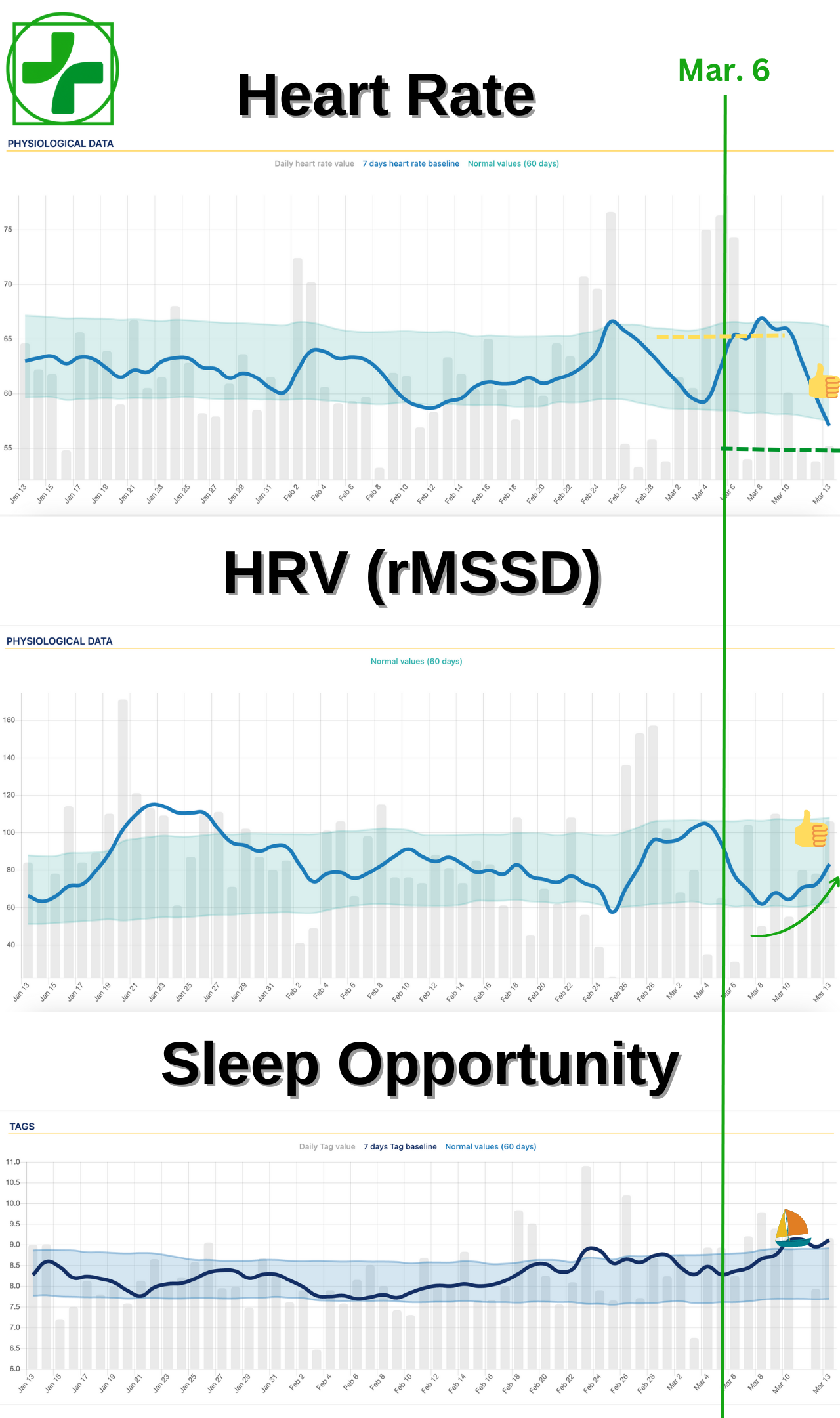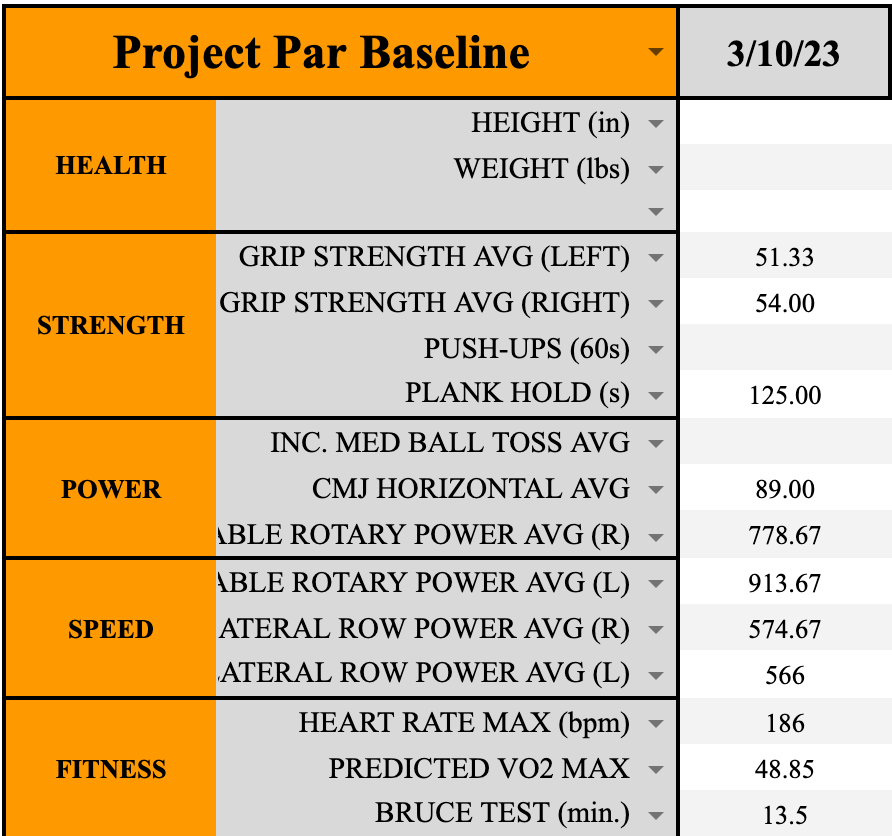Welcome Players! I’m back to full capacity and treated my training as such. I used the opportunity of being away from training for a few weeks to finally put myself through a performance evaluation. I took baseline measurements for all my KPI’s and KPM’s, and now have a plethora of data to guide my programming decisions and measure my golf progress over the remaining 9 months.
Contents:
Training Week in Review
Habit Tracker
Training Log
Physiology Metrics
Skill Practice
Performance Testing
Wrap-Up
Training Week in Review
Back in the saddle again this week, figuratively and literally.
I got back into the gym to resistance train, spent two days performance testing, and then went out for a conditioning bike ride. Plus a solid range session and lots of practice at home.
Felt good to be back training again, let’s see how it went.
Habit Tracker
Wins: It was a MUCH better week this week on the practice side. I was able to avoid my pitfall of not practicing early in the week, touched a club nearly every day, and got a solid range session in. About as good as I could of hoped for following my unplanned hiatus.
Losses: None! I may have done nothing on Sunday, but it was well deserved in the sense that I had practiced hard all week and needed a mental break from practice. I still trained conditioning and spent time filling up my cup.
Training Log
In order of day completed I did the following for physical training:
Rest
RT
Rest
VO2 Max Testing
Performance Testing
Rest
75 min cycling session
Wins: I finally was able to do my baseline performance testing that I had been putting off. It came at a good time too seeing as I was partially de-trained from a week in Colorado followed up by the week of illness. The testing days took max-effort so the extra rest day after was much needed.
Losses: None! I was happy to get both a RT and conditioning session in around my testing days. I’ve got more data to use to improve my training structure and for that I’m pretty happy about.
Physiology Metrics
The three main physiological metrics I track are Heart Rate (HR), Heart Rate Variability via rMSSD (HRV), and Sleep Opportunity (SO).1
Quick legend: Gray bars are daily scores, blue line is trend line, and green range is moving average.
It’s been an up-and-down past few weeks and my physiology has certainly reflected it.
In order to use RHR and HRV as an accurate reflector of parasympathetic recovery you’ve got to be looking at the numbers over a period of time and use the moving averages to establish a range.
This range tells us what’s normal by comparing our current physiology (today’s measurement) with a moving average of the past 7 days scores. Essentially saying not how high/low your score is, but how that measurement compares with your previous 7 day’s measurements and whether or not it’s abnormal compared to your recent history.
This is what makes HRV such an independent measurable and why it shouldn’t be used to compare to population norms or standards.
With that being said I found it interesting that although I put three days of low HR, high HRV, and solid SO together because I’m shortly removed from days of abnormally high measurements my range is still wider than it should be.
Statistically I’m waiting for my body to develop a new habit or pattern that will be reflected in my range but a shortening of the gap and a move closer towards the desired effect, either increase (HRV) or decrease (RHR).
This is why it’s important to be consistent with your daily routines and habits. Hosting healthy patterns and activities during the week just to spend two days tearing them apart doesn’t allow your body to ever develop proper systematic function that contributes to optimal performance.
It’s in a constant battle of recovering from the previous weekend and trying to avoid the next.
For me, I expect this week to be a great week because I’ll be able to put together a 10+ day streak of positive conditions so that my body can establish a new baseline of healthy habits.
Skill Practice
Every golfer’s favorite words, “I think I figured something out.”
Something clicked for me this week while at the range. It’s more of a feel than an objective swing change. It’s a little hard to explain but I’ll try.
While I’m still working to improve the alignment of my hands and club-shaft on take-away, I developed this really solid sensation of starting the downswing with my hips and maintaining tension to feel like I’m flinging the club around where its max speed was at impact.
Previously I’ve always felt that I was swinging the club and getting max speed sometime before or after impact making it feel like I couldn’t control the club face. It also made me feel like my swing was too far in front or behind me, obviously affected the ability to make good contact.
I would be silly not to correlate this feel with a difference in my training, or I should say with the max-effort performance tests I did just the day prior.
I had a really good feel for swinging the club with my torso and having soft hands letting the power generation start from my hips. This lead to more consistent club face control so I struck the ball on the center of the face more often leading to better ball flight and a semi-consistent swing.
After looking at the video I’m still not getting into the ideal position during my backswing, still coming across a bit flight. But my ball striking is much better.
I’ll need to continue to work on alignment while trying to foster this feeling during my swing that helps me maintain tension and produce force without over-swinging or dominating the movement with my upper body.
Performance Testing
This week I was finally able to do my performance testing. A huge component of my overall program was getting objectivity to measure my progress against in relation to my goals.
A quick review on how I laid out the hierarchy of data for Project Par:
Project Par - Goal: Shoot Par in < a year.
OKR’s - Objective Key Results. Objective, time-based goals that track improvement towards accomplishing Project Par Goal.
KPI’s - Key Performance Indicators. Objective metrics in game of Golf that I can use to gauge improvement at the sport and in OKR’s.
KPM’s - Key Performance Metrics. Objective metrics in the gym / training environment that I can use to measure improvement at KPI’s and on golf course.
Each level of objectivity is meant to create alignment with the overall goal long-term as well as provide hard data that can be used to analyze progress and predict improvement. It also creates the framework for my programming.
With this structure I can say to myself, “If variable X isn’t contributing to improving any of my key metrics that I’ve determined to correlate with improvement at my goals, why am I doing it? What should I be doing instead?”
It provides cohesiveness in the program by anchoring small progress with large progress with goal accomplishment.
I’ve found this structure to work incredibly well because it provides accountability AND guidance on next steps when done correctly.
So, as follows are the results of my performance evaluation.
I then filled out my KPM’s and set goals for the end of Q2. I never intended to take baseline measurements at the beginning of training. Ground Zero assessments have more risk than reward in my opinion.
What I mean is if you’re de-trained, not conditioning, and otherwise are just starting a brand new program for a new goal, chances are you won’t be able to tolerate max-effort performance tests very well.
There’s a risk of injury and the multiple days of training lost to testing + recovery.
I think it’s more important at the beginning to just START in general, build good habits, routines, work out the kinks in time management and scheduling that you’ll undoubtedly encounter, and then when you’re more comfortable with the path of your journey to come back around and take real testing numbers to see what your current capability is and then plan to improve it.
After Being able to fill out my KPM’s, I went back and checked out my golf KPI’s. As we near the end of Q1 I’ll be looking to audit my programming and make sure that my metrics and training program is aligned with the improvements I want to see.
I’ve built good habits, have been training consistently, and use a systematic process to track my progress. I’m excited to be able to start to put this data to work and narrow my programming to make improvements at a greater magnitude.
At the end of the day, the goal is to shoot low.
It doesn’t matter how strong I am or how much force I can produce or my level of endurance if I can’t shoot par’s and birdie’s.
That’s why I’ll be auditing my performance metrics along with my golf performance to make sure all my training and preparation is helping me to do the same goal: Shoot Par.
You can watch how I conducted my performance tests below. Any questions on the set-up or testing demands feel free to ask in the comments so you can do your own performance testing too.
Wrap-Up
For being as good a week as it was it certainly didn’t feel like that.
Shaking off the cobwebs of travel and being sick was a drudge. I wasn’t as strong as I remember and my conditioning certainly took a blow. But I was happy to be back doing these things again and I’m comfortable knowing all I need to do is stick to the plan and I’ll be back where I was again in no time.
Then the real progress begins.
See you next week!
To learn more about Heart Rate Variability and the physiology metrics I track, click here






So good to follow you “figuring it out” lol. You should also track the course rating/slope on your KPIs so you can factor that into your stats. If all of your stats are equal but you are playing consistently harder courses, that should be noted as a win, not a plateau!